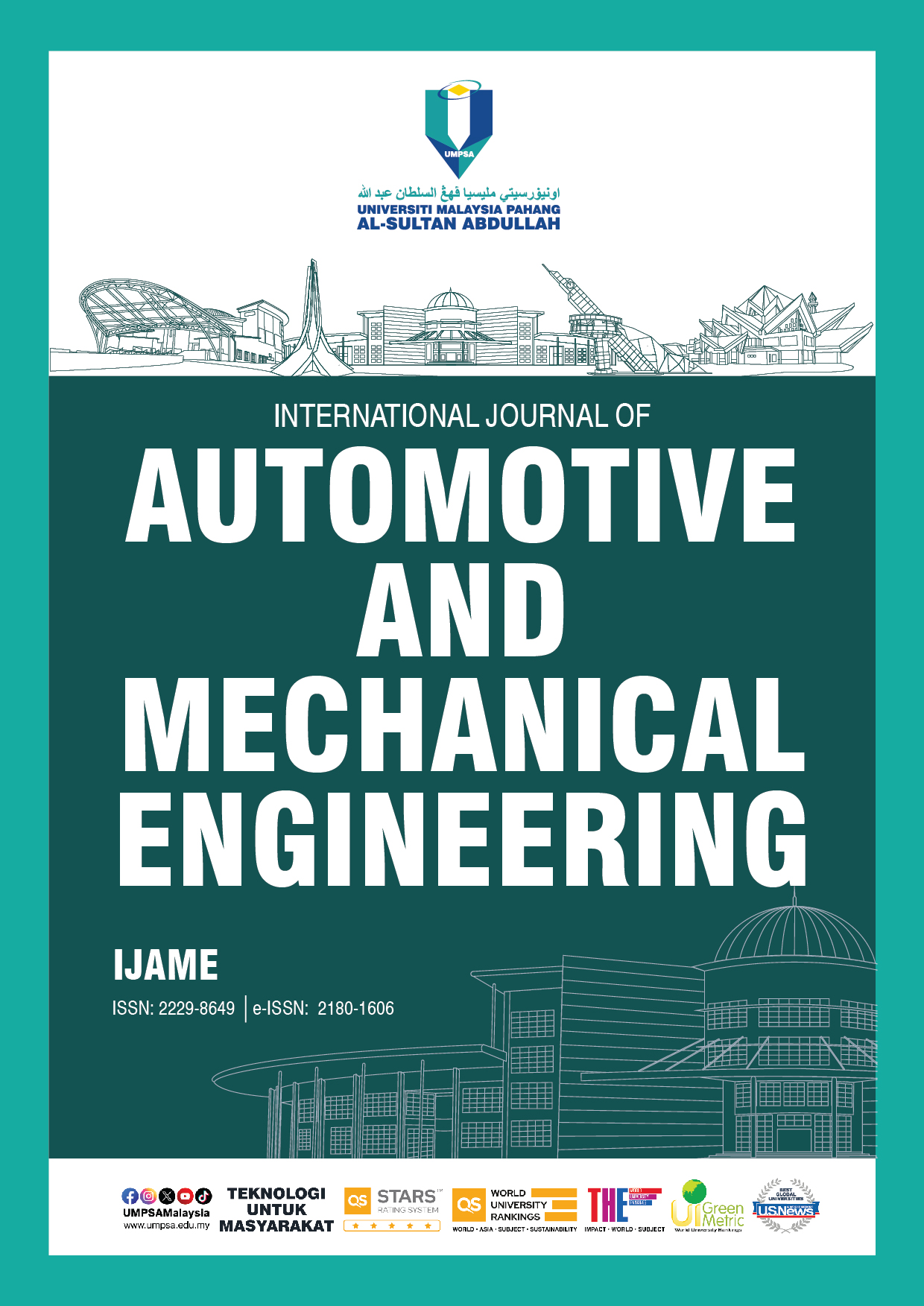Selection of Intrinsic Mode Functions Using Statistical Indicators for Knock Detection in Spark-Ignition Engines
DOI:
https://doi.org/10.15282/ijame.22.2.2025.16.0953Keywords:
SI engine, Knocking, Approximate entropy, Kurtosis, Correlation coefficientAbstract
Spark-ignition (SI) engine knock remains a critical challenge that adversely affects engine performance, efficiency, and durability. Real-time knock detection using engine block vibration signals is complex due to its nonlinear and non-stationary nature. Advanced signal decomposition techniques such as Empirical Mode Decomposition (EMD), Ensemble Empirical Mode Decomposition (EEMD), Complete Ensemble Empirical Mode Decomposition with Adaptive Noise (CEEMDAN), and Variational Mode Decomposition (VMD) are commonly employed to extract knock-related features. However, there is limited consensus on selecting the intrinsic mode functions (IMFs) that best represent knock characteristics. This work introduces a statistical selection criterion based on correlation coefficient (> 0.5), approximate entropy (ApEn > 0.5), and kurtosis (two IMFs with the highest kurtosis values) to identify knock-relevant IMFs. Vibration signals were denoised using Symlet wavelets and then decomposed using the aforementioned techniques. The effectiveness of the selection was evaluated using spectrogram analysis and validated with Maximum Amplitude of Pressure Oscillation (MAPO) values. Results demonstrate that the proposed selection criteria successfully isolated knock-related IMFs, particularly IMF1 and IMF2, when CEEMDAN was applied to signals at 4000 rpm - an improvement over previous works in which only IMF1 was considered for knock analysis. The selected IMFs corresponded to MAPO values exceeding 2 bar, confirming strong knock events. Higher ApEn values, approaching 1 for IMF1 of the vibration signal at 4000 rpm, may be attributed to two strong knock events (cylinders 2 and 3). In contrast, ApEn values around 0.6 for IMF1 at 2800 rpm corresponding to one strong knock (cylinder 1) and one weak knock (cylinder 3) suggest that further investigation is required to confirm the correlation between approximate entropy and knock intensity. This multi-metric approach enhances the robustness and reliability of knock detection and offers a low-complexity, high-accuracy framework suitable for real-time implementation using non-intrusive vibration sensors.
References
[1] Heywood J.B. Internal Combustion Engine Fundamentals, McGraw-Hill Education, 1988.
[2] Kirkpatrick, A.T. Internal Combustion Engines: Applied Thermosciences, John Wiley and Sons: Hoboken, NJ, USA, pp. 206–210, 2021.
[3] H. Shi, Q. Tang, K. Uddeen, B. Johansson, J. Turner, and G. Magnotti, “Effects of multiple spark ignition on engine knock under different compression ratio and fuel octane number conditions,” Fuel, vol. 310, p. 122471, 2022.
[4] H. Shi, K. Uddeen, Y. An, and B. Johansson, “Experimental study on knock mechanism with multiple spark plugs and multiple pressure sensors,” SAE Technical Paper, No. 2020-01-2055, 2020.
[5] D. J. Corrigan, G. Di Blasio, R. Ianniello, N. Silvestri, S. Breda, and S. Fontanesi, “Engine knock detection methods for spark ignition and prechamber combustion systems in a high-performance gasoline direct injection engine,” SAE International Journal of Engines, vol. 15, no. 6, pp. 883-897, 2022.
[6] Yashwanth M. Sai, T. Venugopal, and A. Ramesh, “Experimental and simulation studies to determine the effective octane number in an engine fuelled with ethanol and gasoline.” International Journal of Automotive and Mechanical Engineering, vol. 10, pp. 2057-2069, 2014.
[7] R. Rogóż, Ł. Jan Kapusta, N. Miganakallu, Z. Yang, and J. D. Naber, “Investigation on the knock characteristics in a gasoline direct-injection engine port-injected with water-methanol blends,” Energy Conversion and Management, vol. 258, p. 115415, 2022.
[8] Zhang Q., Pei Y., An Y., Peng Z., Qin J., Shi H., Zhang B., Zhang Z. and Gao D., “Study of water direct injection on knock control and combustion process of a high compression ratio GDI engine.” Fuel, vol. 306, p. 121631, 2021.
[9] X. Dai, Z. Zheng, and Y. Song, “Effect of port water injection on suppressing knock in gasoline direct injection engines,” Energy Science & Engineering, vol. 10, no. 10, pp. 3928-3945, 2022.
[10] K. Rönn, A. Swarts, V. Kalaskar, T. Alger, R. Tripathi, J. Keskiväli, et al., “Low-speed pre-ignition and super-knock in boosted spark-ignition engines: A review,” Progress in Energy and Combustion Science, vol. 95, p. 101064, 2023.
[11] J. Kim, “Acoustic characteristics of the abnormal combustion in a high-compression ratio, spark-ignition engine,” International Journal of Automotive Technology, vol. 23, pp. 1185–1195, 2022.
[12] J. Wang, J. Shi, J. Deng, X. Miao, Y. Liu, S. Pan, et al., “Misfire and knock detection based on the ion current inside a passive pre-chamber of gasoline engine,” Fuel, vol. 311, p. 122528, 2022.
[13] M. Xinke, F. E. I. Shengyi, D. Jun, L. I. Liguang, H. U. Yinuo, M. A. Junjie “Simulation of charged species flow and ion current detection for knock sensing in gasoline engines with active pre-chamber,” SAE Technical Paper, No. 2023-32-0005, 2023.
[14] H. Tajima, T. Tomidokoro, and T. Yokomori, “Deep learning for knock occurrence prediction in SI engines,” Energies, vol. 15, p. 9315, 2022.
[15] N. Li, J. Yang, R. Zhou, and C. Liang “Determination of knock characteristics in spark ignition engines: An approach based on ensemble empirical mode decomposition,” Measurement Science and Technology, vol. 27, no. 4, p. 045109, 2016.
[16] E. Corti, L. Raggini, A. Rossi, A. Brusa, L. Solieri, and D. Corrigan, “Application of low-cost transducers for indirect in-cylinder pressure measurements,” SAE International Journal of Engines, vol. 16, pp. 213–230, 2023.
[17] V. Mittal, “A review of recent advancements in knock detection in spark ignition engines,” Signals, vol. 5, no. 1, pp. 165-180, 2024.
[18] B. Pla, P. Bares, I. Jimenez, and C. Guardiola, “Increasing knock detection sensitivity by combining knock sensor signal with a control-oriented combustion model,” Mechanical Systems and Signal Processing, vol. 168, p. 108665, 2022.
[19] S. Meng, Z. Han, B. Fan, Z. Wu, Q. Shao, and L. Tong, “Experimental study of spatial distribution of knock events in a turbocharged spark-ignition engine,” International Journal of Engine Research, vol. 25, no. 7, pp. 1251-1264, 2024.
[20] N. Hu, H. Zhao, J. Yang, X. Zheng, H. Li, L. Xie, et al., “A knock detection method for a marine micro-ignition dual-fuel engine based on vibration signals,” Polish Maritime Research, vol. 32, no. 1, pp. 111-120, 2025.
[21] N. E. Huang, Z. Shen, S. R. Long, M. C. Wu, H. H. Shih, Q. Zheng et al., “The empirical mode decomposition and the Hilbert spectrum for non-linear and non-stationary time series analysis,” Proceedings of the Royal Society of London. Series A: mathematical, physical and engineering sciences, vol. 454, no. 1971, pp. 903-995, 1998.
[22] T. Q. Nguyen, T. T. D. Nguyen, H. Nguyen-Xuan, N. K. Ngo, “A correlation coefficient approach for evaluation of stiffness degradation of beams under moving load,” Computers, Materials & Continua, vol. 61, no. 1, pp. 27-53, 2019.
[23] M. A. Hashim, M. H. Nasef, A. E. Kabeel, N. M. Ghazaly, “Combustion fault detection technique of spark ignition engine based on wavelet packet transform and artificial neural network,” Alexandria Engineering Journal, vol. 59, no. 5, pp. 3687-3697, 2020.
[24] M. M. Ismail, M. Fawzi, J. Taweekun, and T. Leevijit, “Engine knock detection for a multifuel engine using engine block vibration with statistical approach,” MethodsX, vol. 8, p. 101583, 2021.
[25] El Yacoubi I., and Samuel S., “Frequency coupling analysis in spark ignition engine using bispectral method and ensemble empirical mode decomposition,” SAE Technical Paper, No. 2022-01-0481, 2022.
[26] P. Flandrin, G. Rilling, and P. Goncalves, “Empirical mode decomposition as a filter bank,” IEEE Signal Processing Letters, vol. 11, no. 2, pp. 112-114, 2004.
[27] Z. Wu and N. E. Huang, “Ensemble empirical mode decomposition: A noise-assisted data analysis method,” Advances in adaptive data analysis, vol. 1, no. 1, pp. 1-41, 2009.
[28] H. Han, S. Cho, S. Kwon, and S. B. Cho, “Fault diagnosis using improved complete ensemble empirical mode decomposition with adaptive noise and power-based intrinsic mode function selection algorithm,” Electronics, vol. 7, no. 2, p. 16, 2018.
[29] M. E. Torres, M. A. Colominas, G. Schlotthauer, and P. Flandrin, “A complete ensemble empirical mode decomposition with adaptive noise,” IEEE International conference on acoustics, speech and signal processing (ICASSP), pp. 4144-4147, 2011.
[30] H. Purba, J. T. Musu, S. A. Diria, W. Permono, O. Sadjati, I. Sopandi, et al., “Completed ensemble empirical mode decomposition: A robust signal processing tool to identify sequence strata,” In IOP Conference Series: Earth and Environmental Science, vol. 132, no. 1, p. 012033, 2018.
[31] J. R. Yeh, J. S. Shieh, and N. E. Huang, “Complementary ensemble empirical mode decomposition: A novel noise enhanced data analysis method,” Advances in adaptive data analysis, vol. 2, no. 2, pp. 135-156, 2010.
[32] K. Dragomiretskiy and D. Zosso, “Variational mode decomposition,” IEEE transactions on signal processing, vol. 62, no. 3, pp. 531-544, 2013.
[33] J. Sun, X. Zhang, Q. Tang, Y. Wang, and Y. Li, “Knock recognition of knock sensor signal based on wavelet transform and variational mode decomposition algorithm,” Energy Conversion and Management, vol. 287, p. 117062, 2023.
[34] J. Lian, Z. Liu, H. Wang, and X. Dong, “Adaptive variational mode decomposition method for signal processing based on mode characteristic,” Mechanical Systems and Signal Processing, vol. 107, pp. 53-77, 2018.
[35] J. Kim, “In-cylinder pressure based engine knock classification model for high-compression ratio, automotive spark-ignition engines using various signal decomposition methods,” Energies, vol. 14, 11, p. 3117, 2021.
[36] A. B. Ofner, A .Kefalas, S. Posch, and B. C. Geiger, “Knock detection in combustion engine time series using a theory-guided 1-D convolutional neural network approach,” IEEE/ASME Transactions on Mechatronics, vol. 27, no. 5, pp. 4101-4111, 2022.
[37] A. Kefalas, A. B. Ofner, G. Pirker, S. Posch, B. C. Geiger, and A. Wimmer, “Detection of knocking combustion using the continuous wavelet transformation and a convolutional neural network,” Energies, vol. 14, no. 2, p. 439, 2021.
[38] J. C. M. Hernández, F. G. Madrid, H. F. Quintero, JDR Alzate, “Diesel engine diagnosis based on entropy of vibration signals and machine learning techniques,” Electronics Letters, vol. 58, no. 11, pp. 442-444, 2022.
[39] K. M. Ramachandran and C. P. Tsokos, Mathematical statistics with applications in R. Academic Press, 2020.
[40] Y. He and X. Zhang, “Approximate entropy analysis of the acoustic emission from defects in rolling element bearings,” Journal of Vibration and Acoustics, vol. 134, no. 6, p. 061012, 2012.
[41] S. L. Ding, B. Guo, Z. T. Liu, J. J. Liu, P. Tunestål, and E. Z. Song, “Analysis of the fractal characteristics for combustion instability in a premixed natural gas engine,” Applied thermal engineering, vol. 233, p. 121177, 2023.
[42] H. Shi, K. Uddeen, Y. An, Y. Pei, and B. Johansson, “Statistical study on engine knock oscillation and heat release using multiple spark plugs and pressure sensors,” Fuel, vol. 297, p. 120746, 2021.
[43] F. Bi, T. Ma, J. Zhang, L. Li, and C. Shi, “Knock detection in spark ignition engines base on complementary ensemble empirical mode decomposition-Hilbert transform,” Shock and Vibration, vol. 1, p. 9507540, 2016.
[44] F. Bi, T. Ma, and J. Zhang, “Knock feature extraction in spark ignition engines using EEMD-Hilbert transform,” SAE Technical Paper, No. 2016-01-0087, 2016.
[45] F. Bi, T. Ma, and X. Wang, “Development of a novel knock characteristic detection method for gasoline engines based on wavelet-denoising and EMD decomposition,” Mechanical Systems and Signal Processing, vol. 117, pp. 517-536, 2019.
[46] M. A. Kabir and C. Shahnaz, “Denoising of ECG signals based on noise reduction algorithms in EMD and wavelet domains,” Biomedical Signal Processing and Control, vol. 7, no. 5, pp. 481-489, 2012.
[47] X. Bi, J. Lin, D. Tang, F. Bi, X. Li, X. Yang, et al., “VMD-KFCM algorithm for the fault diagnosis of diesel engine vibration signals,” Energies, vol. 13, no. 1, p. 228, 2020.
[48] M. Moradi, G. Galanopoulos, T. Kuiters, and D. Zarouchas, “A novel intelligent health indicator using acoustic waves: CEEMDAN-driven semi-supervised ensemble deep learning,” Mechanical Systems and Signal Processing, vol. 224, p. 112156, 2025.
[49] P. A. Jargowsky and R. Yang, “Descriptive and inferential statistics,” in Encyclopedia of Social Measurement, pp. 659-668, Elsevier Inc. 2004.
[50] S. Pincus, “Approximate entropy (ApEn) as a complexity measure,” Chaos: An Interdisciplinary Journal of Non-linear Science, vol. 5, no. 1, pp. 110-117, 1995.
Downloads
Published
Issue
Section
License
Copyright (c) 2025 The Author(s)

This work is licensed under a Creative Commons Attribution-NonCommercial 4.0 International License.







